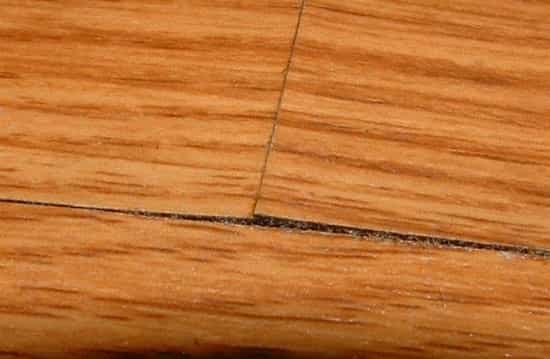To fix buckled vinyl floor, get extra vinyl matching the existing one. Place it on top of the damaged area to get the exact dimensions and cut it out. Use a hot box to weaken the underlying adhesive and remove the cut-out area.
Vinyl floor buckling is when the floor lifts a few inches from the subfloor, on one or several areas, making it uneven. On vinyl floors, it is caused by an extreme reaction to exposure to moisture.
Spread an adhesive evenly using a notched trowel on the area being repaired and install the new vinyl. Make sure to secure the area with a heavy object to ensure the floor is properly fixed
When you want the feel and the look of wooden flooring at a cheaper price, only that at some point you may deal with buckling and peeling if not properly fitted and maintained.
Why do vinyl floors buckle?

To fix a buckled vinyl floor is not the ultimate solution. The best thing to do is to find out the problem causing the buckling and fix it as well to avoid the same case in the future.
Moisture from the subfloor
During installation, if the subfloor is not properly waterproofed, moisture will rise and weaken the adhesive used for installation, causing the floor to buckle. A vapor barrier should always be installed under the vinyl planks to make it waterproof.
Low-quality adhesives
Top-quality adhesives should be used during the glue-down process of vinyl flooring to the subfloor. Confirm the expiry date on each one before application, and follow the manufacturer’s instructions for the best results. Outdated adhesives will make your floor buckle over a shorter period.
Premium adhesives make more secure bonds than inexpensive adhesives, which get loose easily and make the floor buckle.
Exposure to heat
Like other materials, when sunlight or heat is exposed to vinyl flooring the floor becomes warmer and may expand slightly, making the vinyl planks buckle. In cold weather, the planks will contract to leave spaces in between the planks. When tiles leave spaces between them, it is referred to as gapping.
In houses where large windows and doors are hit directly by the sun, the adhesive holding the floor will release the bonds because of the heat making the vinyl planks shift, mostly in cases where the vinyl planks have an inner fiberglass layer.
Dragging heavy objects on the floor
All floors should be taken good care of, whether vinyl or not. Dragging heavy objects scratches the planks and buckles any loose-laying vinyl planks. Loose lay planks are used in commercial areas or residential rooms.
Lift heavy objects rather than dragging them when moving to minimize floor damage. Daily scratches can be minimized by placing felt pads under heavy furniture.
How to fix a buckled vinyl flooring
Sometimes it is difficult to fix buckled vinyl floor surfaces and the best solution is replacing the affected areas. However, Before fixing, check out the cause of buckling and fix that first.
- Place a piece of vinyl floor matching the pre-existing flooring on top of the area to be replaced. This piece should be larger than the damaged area and secure it along the edges with painter’s tape.
Make sure the patterns match the area you are replacing.
- Cut through the patch and the damaged section of the vinyl flooring.
- Remove the painter’s tape and patch.
- Place the aluminum foil on the area that is damaged and use an iron box to soften the adhesive under the vinyl.
- Scrape up the damaged area using a putty knife
- Using mineral spirits soften the existing adhesive and scrape it off as much as you can. Make sure to use rubber gloves because mineral spirits can be harmful to your hands.
- Using a notched trowel, spread evenly adhesive to receive the new patch and carefully place it into place.
- Wipe off any adhesive that is seeping and secure the edges with painter’s tape and secure them with a brick or something just heavy enough to hold them into place.
- Give the adhesive time to dry and remove the bricks and the masking tape.
Things you will need:
- Extra vinyl floor matching the pre-existing floor
- Approved vinyl floor adhesive
- Clothes iron
- Rubber gloves
- Aluminum foil
- Putty knife
- Painters tape
- Mineral spirits
- Notched trowel
How to prevent vinyl floors from buckling
- During installation, use a more effective moisture barrier to protect the vinyl sheets from groundwater slippage and mold.
It is also advisable to seek professional advice or have a professional test if the subfloor is dry before installation because sometimes it’s hard to tell if it’s wet or dry enough.
- For a longer-lasting vinyl floor, use premium adhesives while gluing down, and make sure to follow the manufacturer’s instructions.
- In the cold season (winter) when gapping occurs, clean in between the vinyl planks to remove the dust that accumulates in the gaps.
When the warm season returns (summer) and the dust is not removed, it prevents the planks from fitting back together, causing buckling. If unable to clean properly, seek professional assistance.
- In cases where there are large windows, use curtains, blinders, or tint the windows to protect direct heat from the sun hitting the vinyl planks.
- If the glue seems to be releasing the bond, carefully peel the vinyl plank/sheet, Scrap off/remove the failed adhesive, apply new adhesive and fit the vinyl sheet into place. Roll over the buckled area and ensure the adhesive properly works.
